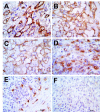Analysis of VEGFR-2 and PDGFR-β expression in canine splenic hemangiosarcoma to identify drug repositioning candidates
- PMID: 39131208
- PMCID: PMC11315467
- DOI: 10.29374/2527-2179.bjvm001524
Analysis of VEGFR-2 and PDGFR-β expression in canine splenic hemangiosarcoma to identify drug repositioning candidates
Abstract
Splenic tumors are very common in dogs, and canine hemangiosarcoma (HSA) is one of the most important malignant splenic tumors. Surgery followed by chemotherapy (anthracycline-based protocols) is recommended for treating canine HSA; however, patients still do not achieve long-term survival. Therefore, this research aimed to assess vascular endothelial growth factor receptor-2 (VEGFR-2) and platelet-derived growth factor receptor-β (PDGFR-β) gene expression in formalin-fixed tissues, evaluate the quality of mRNA for quantitative polymerase chain reaction (qPCR) analysis and identify drug repositioning candidates based on VEGFR-2 and PDGFR-β. qPCR analysis identified the relative expression of heterogeneous VEGFR-2 and PDGFR-β, with samples showing no transcripts or very low expression and those with higher relative quantification for both genes. We then used immunohistochemistry to correlate the relative quantification of VEGFR-2 and PDGFR-β transcripts with respective higher protein expression to validate our results. In the next step, we evaluated drug repositioning candidates and identified small molecule inhibitors (i.e. sorafenib) and natural compounds (curcumin and resveratrol) with the ability to block VEGFR-2 and PDGFR-β genes. Overall, our results indicated that VEGFR-2 and PDGFR-β expression is highly variable among canine HSA samples and different drugs can block the expression of both genes. Therefore, a personalized approach could be useful for selecting anti-VEGFR-2 and PDGFR-β therapies and both genes are potential candidates for future oncological panels.
Os tumores esplênicos são muito comuns em cães, e o hemangiosarcoma (HSA) é um dos tumores esplênicos malignos mais importantes em cães. A cirurgia seguida de quimioterapia (protocolos baseados em antraciclinas) é a abordagem terapêutica mais recomendada para o tratamento da HSA canino; no entanto, os pacientes ainda não alcançam longa sobrevida após tratamento. Portanto, esta pesquisa teve como objetivo avaliar a expressão do receptor do fator de crescimento endotelial vascular-2 (VEGFR-2) e do receptor do fator de crescimento derivado de plaquetas-β (PDGFR-β) em tecidos fixados em formalina e identificar candidatos ao reposicionamento de medicamentos baseado na expressão desses genes. A análise qPCR identificou a expressão relativa heterogênea de VEGFR-2 e PDGFR-β, com amostras sem transcritos ou com expressão muito baixa ou amostras com alta quantificação relativa para ambos os genes. Em seguida, foi realizada o exame imuno-histoquímico para correlacionar a quantificação relativa dos transcritos de VEGFR-2 e PDGFR-β com a respectiva maior expressão proteica para validar nossos resultados. Na próxima etapa, avaliamos candidatos ao reposicionamento de medicamentos e identificamos inibidores de moléculas pequenas (ou seja, sorafenibe) e compostos naturais (curcumina e resveratrol) com capacidade de bloquear os genes VEGFR-2 e PDGFR-β. No geral, nossos resultados indicaram que a expressão de VEGFR-2 e PDGFR-β é altamente variável entre amostras caninas de HSA e diferentes drogas podem bloquear a expressão de ambos os genes. Portanto, uma abordagem personalizada poderia ser útil para selecionar terapias anti-VEGFR-2 e PDGFR-β e ambos os genes são potenciais candidatos para futuros painéis oncológicos.
Keywords: dogs; drug repurposing; endothelial cells; spleen.
Conflict of interest statement
Conflict of interests: Two authors of this study are all current employees of VetPrecision Laboratory (I.S.T.V. and C.F.F-A) and Institute of Veterinary Oncology – IOVET (C.E.F-A), and hold vested or unvested equity in both companies. This does not alter the authors’ adherence to Cell Insight policies.
Figures





Similar articles
-
Expression of platelet-derived growth factor and its receptors in spontaneous canine hemangiosarcoma and cutaneous hemangioma.Histol Histopathol. 2012 May;27(5):601-7. doi: 10.14670/HH-27.601. Histol Histopathol. 2012. PMID: 22419024
-
Expression of VEGFR and PDGFR-α/-β in 187 canine nasal carcinomas.Vet Comp Oncol. 2017 Sep;15(3):1041-1050. doi: 10.1111/vco.12245. Epub 2016 Jun 9. Vet Comp Oncol. 2017. PMID: 27278115
-
Contrasting prognostic implications of platelet-derived growth factor receptor-β and vascular endothelial growth factor receptor-2 in patients with angiosarcoma.Ann Surg Oncol. 2011 Oct;18(10):2841-50. doi: 10.1245/s10434-011-1640-4. Epub 2011 Mar 16. Ann Surg Oncol. 2011. PMID: 21409488
-
Intracranial meningiomas, the VEGF-A pathway, and peritumoral brain oedema.Dan Med J. 2013 Apr;60(4):B4626. Dan Med J. 2013. PMID: 23651727 Review.
-
Blocking fibrotic signaling in fibroblasts from patients with carpal tunnel syndrome.J Cell Physiol. 2018 Mar;233(3):2067-2074. doi: 10.1002/jcp.25901. Epub 2017 May 3. J Cell Physiol. 2018. PMID: 28294324 Free PMC article. Review.
References
-
- Asa S. A., Murai A., Murakami M., Hoshino Y., Mori T., Maruo K., Khater A., El-Sawak A., el-Aziz E. A., Yanai T., Sakai H. Expression of platelet-derived growth factor and its receptors in spontaneous canine hemangiosarcoma and cutaneous hemangioma. Histology and Histopathology. 2012;27(5):601–607. - PubMed
-
- Bernabe L. F., Portela R., Nguyen S., Kisseberth W. C., Pennell M., Yancey M. F., London C. A. Evaluation of the adverse event profile and pharmacodynamics of toceranib phosphate administered to dogs with solid tumors at doses below the maximum tolerated dose. BMC Veterinary Research. 2013;9(1):190. doi: 10.1186/1746-6148-9-190. - DOI - PMC - PubMed
-
- Bianco A. V., Abood S., Mutsaers A., Woods J. P., Coe J. B., Verbrugghe A. Unconventional diets and nutritional supplements are more common in dogs with cancer compared to healthy dogs: An online global survey of 345 dog owners. Veterinary and Comparative Oncology. 2020;18(4):706–717. doi: 10.1111/vco.12599. - DOI - PubMed
-
- Campigotto G., Alba D. F., Sulzbach M. M., Dos Santos D. S., Souza C. F., Baldissera M. D., Gundel S., Ourique A. F., Zimmer F., Petrolli T. G., Paiano D., Silva A. S. Dog food production using curcumin as antioxidant: Effects of intake on animal growth, health and feed conservation. Archives of Animal Nutrition. 2020;74(5):397–413. doi: 10.1080/1745039X.2020.1769442. - DOI - PubMed
LinkOut - more resources
Full Text Sources
Miscellaneous
